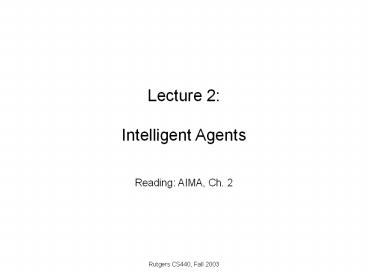Lecture 2: Intelligent Agents - PowerPoint PPT Presentation
Title:
Lecture 2: Intelligent Agents
Description:
Solitaire. Rutgers CS440, Fall 2003. Properties of task environments (cont'd) ... Solitaire. Rutgers CS440, Fall 2003. Structure of agents ... – PowerPoint PPT presentation
Number of Views:93
Avg rating:3.0/5.0
Title: Lecture 2: Intelligent Agents
1
Lecture 2 Intelligent Agents
- Reading AIMA, Ch. 2
2
What is an agent?
- An entity in an environment that perceives it
through sensors and acts upon it through
actuators.
Percepts
Environment
Agent
sensor
Modified from "A Kalman Filter Model of the
Visual Cortex", by P. Rao, Neural Computation
9(4)721--763, 1997
actuator
Actions
Agents human, robot, softbot, thermostat,
etc. Agents act on environment to achieve a goal.
3
Agent function program
- Agents choice of action is based on a sequence
of percepts - Agent is specified by an agent function f that
maps sequences of percepts Y to actions a - Agent program implements agent function on a
physical architecture - Easy solution table that maps every possible
sequence Y to an action a - Problem not feasible
4
Example Vacuum-cleaner world
A
B
- Percepts location and contents, e.g., (A,dirty)
- Actions move, clean, do nothing LEFT, RIGHT,
SUCK, NOP
5
Vacuum-cleaner world agent function
- What is the right function?
- Can the function be implemented in a short
program?
6
The right agent function rational behavior
- Rational agent is the one that does the right
thing functional table is filled out correctly - What is the right thing?
- Define success through a performance measure, r
- Vacuum-cleaner world
- 1 point for each clean square in time T
- 1 point for clean square, -1 for each move
- -1000 for more than k dirty squares
- Rational agentAn agent who selects an action
that is expected to maximize the performance
measure for a given percept sequence and its
built-in knowledge - Ideal agent maximizes actual performance, but
needs to be omniscient. Impossible! - Builds a model of environment.
7
Properties of a rational agent
- Maximize expected performance
- Gathers information does actions to modify
future percepts - Explores in unknown environments
- Learns from what it has perceived so far(dung
beetle, sphex wasp) - Autonomous increase its knowledge by learning
8
Task environment
- To design a rational agent we need to specify a
task environment problem to which the agent is
a solution - P.E.A.S. Performance measure Environment Act
uators Sensors - Example automated taxi driver
- Performance measure safe, fast, legal,
comfortable, maximize profits - Environment roads, other traffic, pedestrians,
customers - Actuators steering, accelerator, brake, signal,
horn - Sensors cameras, sonar, speedometer, GPS
9
More PEAS examples
- College test-taker
- Internet shopping agent
- Mars lander
- The president
10
Properties of task environments
Solitaire Backgammon Internet shopping Taxi
Observable (hidden)
Deterministic (stochastic)
Episodic (sequential)
Static (Dynamic)
Discrete (Continuous)
Single-agent (multi-agent)
11
Properties of task environments (contd)
Solitaire Backgammon Internet shopping Taxi
Observable (hidden) Yes Yes No No
Deterministic (stochastic)
Episodic (sequential)
Static (Dynamic)
Discrete (Continuous)
Single-agent (multi-agent)
12
Properties of task environments (contd)
Solitaire Backgammon Internet shopping Taxi
Observable (hidden) Yes Yes No No
Deterministic (stochastic) Yes No Partly No
Episodic (sequential)
Static (Dynamic)
Discrete (Continuous)
Single-agent (multi-agent)
13
Properties of task environments (contd)
Solitaire Backgammon Internet shopping Taxi
Observable (hidden) Yes Yes No No
Deterministic (stochastic) Yes No Partly No
Episodic (sequential) No No No No
Static (Dynamic)
Discrete (Continuous)
Single-agent (multi-agent)
14
Properties of task environments (contd)
Solitaire Backgammon Internet shopping Taxi
Observable (hidden) Yes Yes No No
Deterministic (stochastic) Yes No Partly No
Episodic (sequential) No No No No
Static (Dynamic) Yes Semi Semi No
Discrete (Continuous)
Single-agent (multi-agent)
15
Properties of task environments (contd)
Solitaire Backgammon Internet shopping Taxi
Observable (hidden) Yes Yes No No
Deterministic (stochastic) Yes No Partly No
Episodic (sequential) No No No No
Static (Dynamic) Yes Semi Semi No
Discrete (Continuous) Yes Yes Yes No
Single-agent (multi-agent)
16
Properties of task environments (contd)
Solitaire Backgammon Internet shopping Taxi
Observable (hidden) Yes Yes No No
Deterministic (stochastic) Yes No Partly No
Episodic (sequential) No No No No
Static (Dynamic) Yes Semi Semi No
Discrete (Continuous) Yes Yes Yes No
Single-agent (multi-agent) Yes No No No
17
Structure of agents
- Goal of AI give task environment, construct
agent function, and design an agent program that
implements agent function on a particular
architecture - Skeleton agent
function SKELETON-AGENT(perceptt) returns
actiont static state, the agents memory of the
world statet Update-State(statet-1,,perceptt,
actiont-1) actiont Choose-Best-Action(statet)
statet Update-Memory(statet,actiont) return
action
18
Skeleton agent
- Graphical depiction (we will see more of it later
in the semester)
at1
st1
yt1
19
Agent types
- Simplest agentTable-driven agent for each
percept sequence Y, has a table entry with
associated action
function TABLE-DRIVEN-AGENT( percept ) returns
action static sequence or percepts percepts
Update-Percepts( percept ) action Table(
percepts ) return action
- Four basic types, in order of increasing
complexity - Simple reflex agent
- Model-based reflex agent (reflex agent with
state) - Goal-based agent
- Utility-driven agent
20
Simple reflex agent
function REFLEX_VACUUM_AGENT( percept ) returns
action (location,status) UPDATE_STATE(
percept ) if status DIRTY then action
SUCK else if location A then return
RIGHT else if location B then return LEFT
return action
21
Model-based reflex agent
22
Goal-driven agent
23
Utility-based agent
24
Learning agent
Any other agent

